Labrador tea, named after the swamps of Labrador where it loves to grow, was the herbal drink of choice by the indigenous peoples inhabiting the Arctic regions of North America.
Here is a sneak peak at one of the most popular requests from the survey I published a couple of weeks ago. You, my readers, love to learn about unusual ingredients! I used to do posts with unusual ingredients a lot more and I really loved those post. Not sure why I put them aside but let’s bring them back. And the first unusual ingredient to bring back this series is the Labrador Tea.
Just to put some minds at ease, no dog is involved in the process of making Labrador Tea 🙂 , rather the name comes from the Labrador region, one of the few places on earth where this plant grows. And I just so happened to have this tea in my pantry!

Labrador What Tea?
So in my survey post I had also attached a rather unusual Northwest Territories holiday dinner menu, the kind that might have been served 50 years ago. I think most of you loved reading the menu but were quite glad NOT to attend it ha ha. The beverage of choice was either broth from the main dish or Labrador Tea. And I remembered I had a forgotten bag of Labrador Tea at home so I brew you a pot!
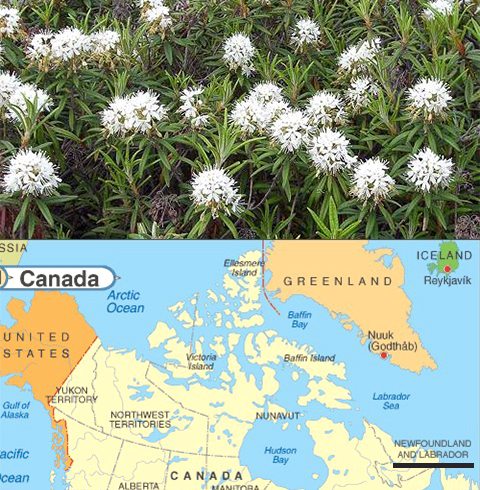
Labrador Tea shrub ©blog.emergencyoutdoors.com and map ©maps.com
Labrador tea, or Ledum groelandicum, is also know as swamp tea, Hudson’s Bay tea, Indian tea, James tea and marsh tea. This slow growing aromatic, evergreen shrub primarily grows in the wet, peaty soils found in Alaska, Greenland and Labrador. Young leaves point upwards with a white interior and older leaves point downwards and have a rust colored interior.
Although no medical research supports the claims, this tea has been used by the Athabaskan and Inuit people for millenniums to help coughs, colds, bronchial infections, and pulmonary infections. Labrador tea is also reported to be a mild sedative and tranquilizer, good for digestion, soothes skin rashes and sores, regenerates the liver, and is an antioxidant.
Eventually Hudson Bay traders got their hands on this tea and sold the leaves. During the American Revolution, Labrador tea was a pleasant and popular substitute for commercial tea. They also realized, like the Germans, that if they added leaves to beer it would make the beer more intoxicating. Modern science now tells us that Labrador tea can have narcotic properties if taken in high doses, and in very rare overdoses can lead to paralysis and death.
Do not fear! Two cups of Labrador tea a day is totally safe, do not worry, but more is not recommend. So what else can you do with Labrador leaves besides tea? Glad you asked! You can actually use it to spice and marinate meat by placing the meat in a decoction made from the leaves and branches (I so have to try this!). It seasons wild game beautifully, you can also add it to spring rolls in lieu of mint, and some us a strong decoction as a substitute for vanilla in desserts.
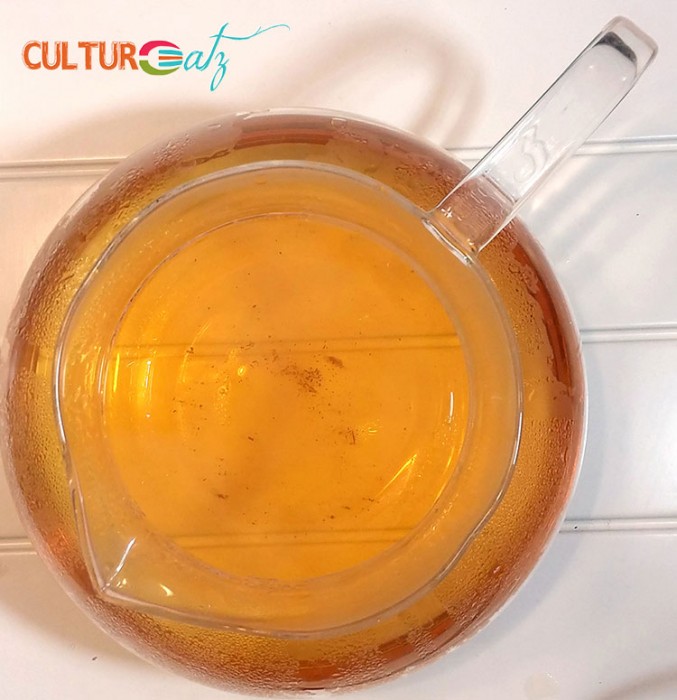
Don’t just steep the leaves. It is really best to prepare this tea like a decoction. Bring to a boil some water. Measure 1 tsp to 1 tbsp (personal taste) of tea leaves per cup of water, and rolls the leaves in your hand to break them up. Add the leaves to the boiling water and reduce heat to a simmer, leaving the tea to simmer for 5 min, remove from heat and rest for 2 min before straining. You may wish to sweeten the tea with maple syrup or honey.
Now I will be honest, it is not the best tea you will taste in your entire life (which is why it was forgotten in my pantry). I would say the taste reminds me of a grassy pine or balsam fir, and just the the slightest whiff of turpentine. But remember when you live in harsh environments, like the Arctic, you make do with what the land gives you.
It’s weird, it’s unusual, I have to try it. So I am including this post in my newly renamed category, totally tongue in cheek: Evelyne’s Unusuals. These are informative and discovery posts. You will learn something and sometimes I also include a recipe. I have done my best to add here all the unusual foods I have tried in the past (old posts, be kind, I have grown as a blogger 🙂 ). Check some of them out now…..
Thai Peachy Garlic Scape Soup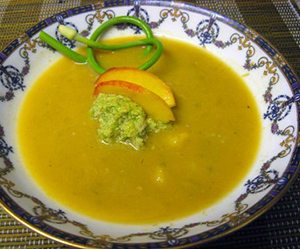 |
Sesame Leaves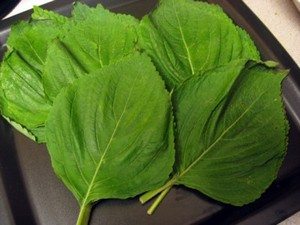 |
Black Horn Nut |
Banana Flower Salad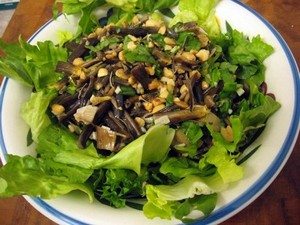 |




I make my tea with the fruit, I harvest it here in Alaska. I can’t find any h information on using the fruit in teas. Have you by chance heard of anything?
Hi Denise thanks for your comment. Wow you can pick your own labrador, pretty cool. Alas I have no info on the fruit either.
Never heard of this tea! But now that I have, I must try it 🙂 thanks for sharing!
Thanks Eileen, hope you find some to try!
Wow, I am a tea lover (always turn to my lemon and ginger when I have a cold too) so this Labrador tea sounds fascinating! I dream of visiting Alaska, you are so lucky to have been!
Oh I have not been to Alaska, but you can buy this tea in Quebec at certain shops. Glad this is a great new discovery for you.
How fascinating. Thank you for this. A shame it was not super tasty. But sometimes things can be an acquired taste. I guess if you grew up with it you would love it.
That is an excellent point Serina!
Love teas, even if I am a coffee snob, and loved learning more. Very interesting.
Oh I kinda prefer coffee too but original teas, totally fun to explore 🙂
I used to go nuts for tea, then I discovered these energy fizz sticks, a substitute for coffee, tea and or caffeine. So stopped my daily quest for tea awesomeness. This makes me wanna get back on the tea train. Gotta admit tho, I have never heard of this tea before.
Well I have never heard of energy fizz sticks! Off to google them lol. Thanks for the comment!
“During the American Revolution, Labrador tea was a pleasant and popular substitute for commercial tea.”
Um, NOT pleasant or popular!! LOL (I say this as a former re-enactor of the American Rev War, we never used it at camp, and it was never even actually brought up in discussions or in menus provided to us.)
LOL I love your perspective and ‘experience’ with this tea Susan, thanks for sharing! But back then they had less options or things to compare with, maybe it was pleasant back then lol.
Haha, I was also slightly worried when I read the post name!! I love tea of all flavours, but I have never heard of this before. I love your description of the taste. I drink a lot of herbal teas and didn’t like the taste of many of them at first but you get kind of used to them. I wonder if this would be available in the UK.
Ha ha no, dogs are safe! I have no idea if you can find it in the UK but probably can order online from a Canadian site?
Thanks for sharing more about this tea. It’s like our indigenous bush teas we get here ?
Oh really, would be fun to compare them side by side.
Can’t imagine my life without tea! Have never heard of labrador tea..sounds really interesting, Evelyne.
Tea is so important and kinda brings the world together since so many teas come from so many countries.
Tea is one of my best friends – and I love being informed about NEW TYPES I have never heard of!! 😀
So happy that you have this new discovery to add to your must try list I hope! Hit me up if you want some.
Ooh this is so exciting! We foraged for some while we were in the Yukon and had some delicious tea 😀
No way, I cannot believe you actually forage for Labrador tea, so cool Lorraine!
Whew. My dog is very relieved that no labs were involved in making this tea 🙂 What an interesting tea with a long history!
Indeed dizzymissizzy is totally safe and sound Liz. Glad you liked the tea discovery!